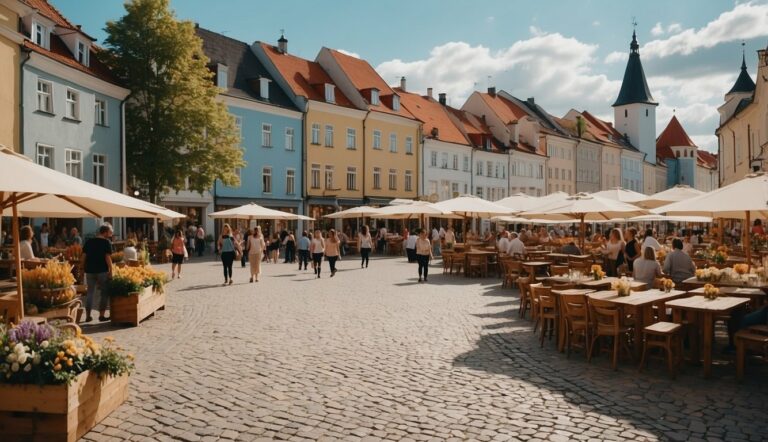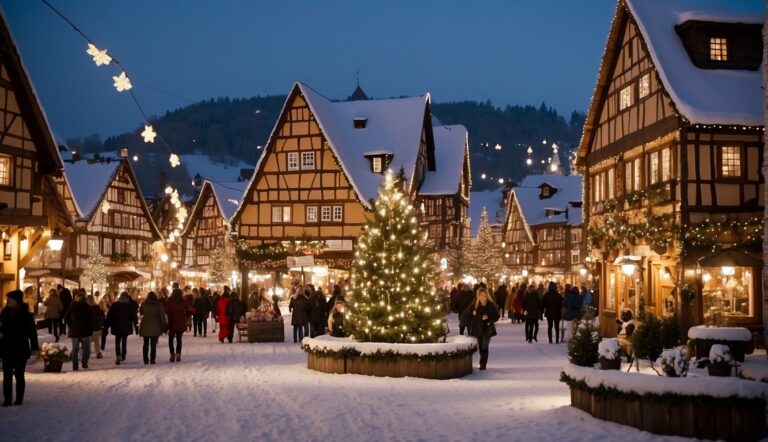Exploring Brazilian Christmas Traditions: Celebrate the Holidays in Brazil
Christmas in Brazil reflects a blend of global traditions and local cultural influences, with celebrations taking place in a unique atmosphere given the country’s Southern Hemisphere location.
During the festive season, Brazil is immersed in the warmth of its summer, contrasting the typical winter scenes associated with Christmas in many other countries.
Vibrant decorations, festive foods, and a distinct tropical mood mark the holiday.

Brazil’s celebratory customs incorporate various activities, from religious practices to secular merrymaking.
Midnight Mass, known as Missa do Galo, is a significant religious event that sees many Brazilians congregate in churches to mark the birth of Jesus.
On the more secular end, exchanging gifts, decorating homes with colourful lights, and setting up Christmas trees are common practices.
The figure of Santa Claus, called Papai Noel, adapts to the local climate by wearing lighter attire suitable for the Brazilian heat.
Brazilians infuse their Christmas celebrations with their rich cultural tapestry, featuring influences from Portuguese heritage and Italian, German, and other cultures that have shaped Brazil’s cultural landscape.
Traditional foods served during Christmas include pork, turkey, and ham, often accompanied by rice with raisins and farofa, a seasoned manioc flour mixture.
Desserts typically feature fruits, emphasizing the season’s abundance and the enjoyment of tropical flavours amid Christmas festivities.
History and Cultural Significance
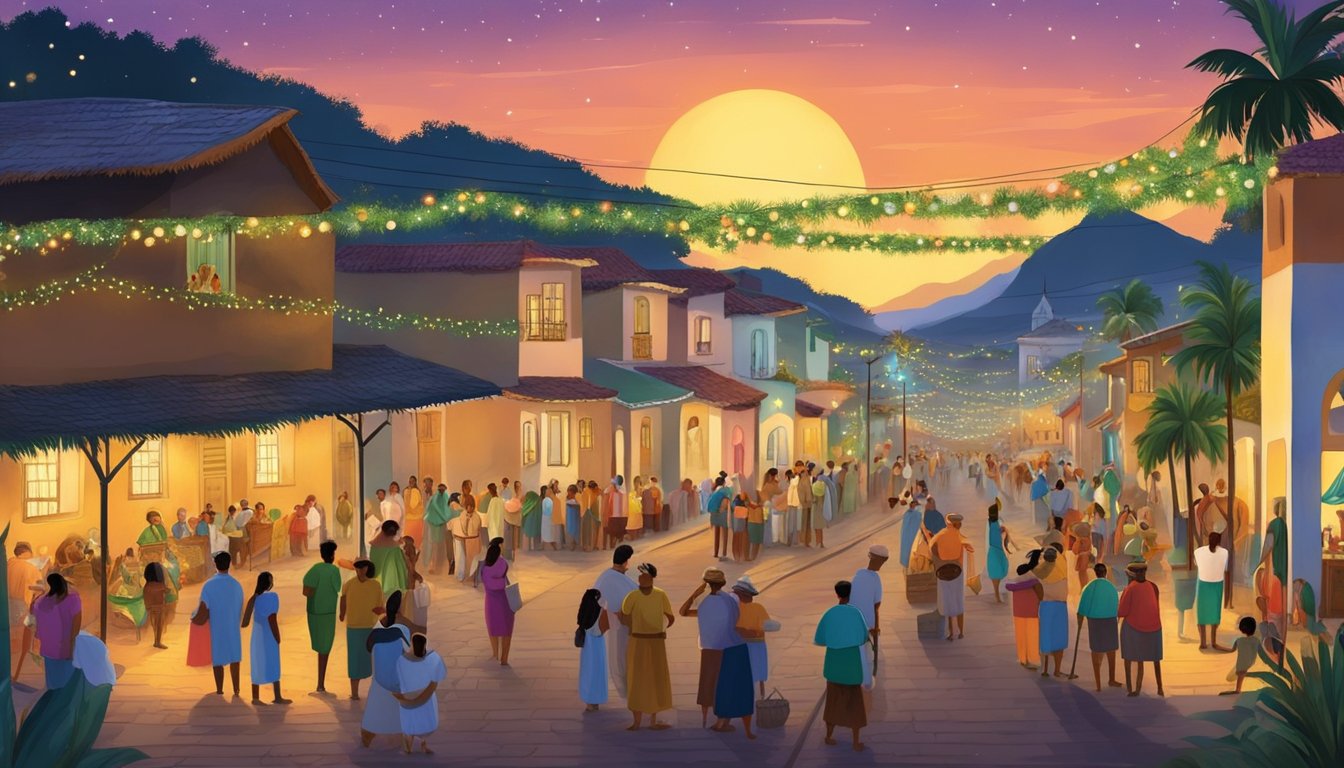
Christmas in Brazil reflects a unique blend of Portuguese and native influences shaped by Catholic traditions and festive international practices. This profoundly significant holiday has evolved over centuries to incorporate diverse cultural elements.
Influence of Portuguese Traditions
Portugal’s colonization of Brazil brought the celebration of Christmas, known as “Natal” in Portuguese. Traditional Portuguese festivities have left an indelible mark on how Brazil celebrates Christmas.
Folk dances, foods, and religious practices during the holiday are largely derived from Portuguese customs.
Catholic Traditions in Brazil
Brazil’s identity as a predominantly Catholic nation has deeply influenced its Christmas celebrations.
The Midnight Mass, or “Missa do Galo,” remains a central tradition, symbolizing a moment of religious reflection and community.
Additionally, the depiction of the nativity scene, or “Presépio,” introduced by Franciscan friars, continues to represent the holiday’s religious roots significantly.
Adaptation of International Celebrations
International customs like Santa Claus, known in Brazil as “Papai Noel,” have been adapted to fit the local context.
Due to the summer heat, Papai Noel dresses in a silk suit, bringing gifts to well-behaved children.
This adaptation showcases Brazil’s openness to integrating global traditions into its Christmas celebrations while maintaining a distinct Brazilian flair.
Traditional Celebrations and Customs
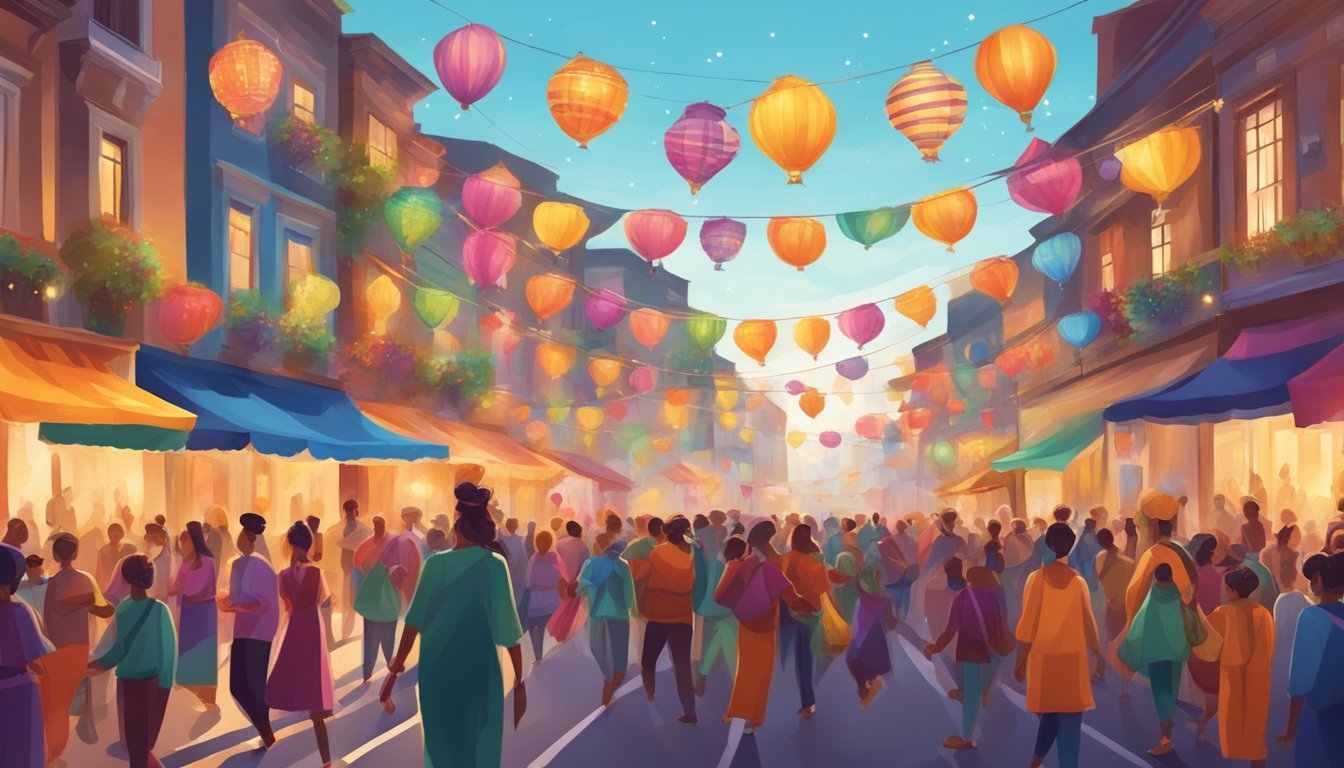
Christmas in Brazil reflects a blend of traditions and practices which combine local influences with international festive customs.
Nativity Scenes Across Brazil
Nativity scenes, known as Presépio, are prominent in Brazilian Christmas celebrations.
They are commonly displayed in churches, homes, and public spaces, each showcasing intricate representations of the birth of Jesus Christ, often adapting local features and Brazilian cultural elements.
Midnight Mass – Missa do Galo
Missa do Galo, or Midnight Mass, is central to the Christmas Eve tradition.
Families attend the mass, which lasts until the early hours of Christmas Day.
The service often culminates in a celebratory display of fireworks, marking the conclusion of the religious ceremony.
Unique Brazilian Christmas Traditions
Brazilian Christmas festivities include a vibrant blend of universal and distinctive customs:
- Papai Noel: Santa Claus, or Papai Noel as he’s known in Brazil, adapts to the tropical climate by wearing lighter red silk attire. He delivers gifts to children who leave a sock by the window.
- Amigo Secreto: Similar to Secret Santa, Amigo Secreto is a widespread gift exchange practice where participants anonymously exchange presents during holiday gatherings.
Christmas Eve and Day Festivities
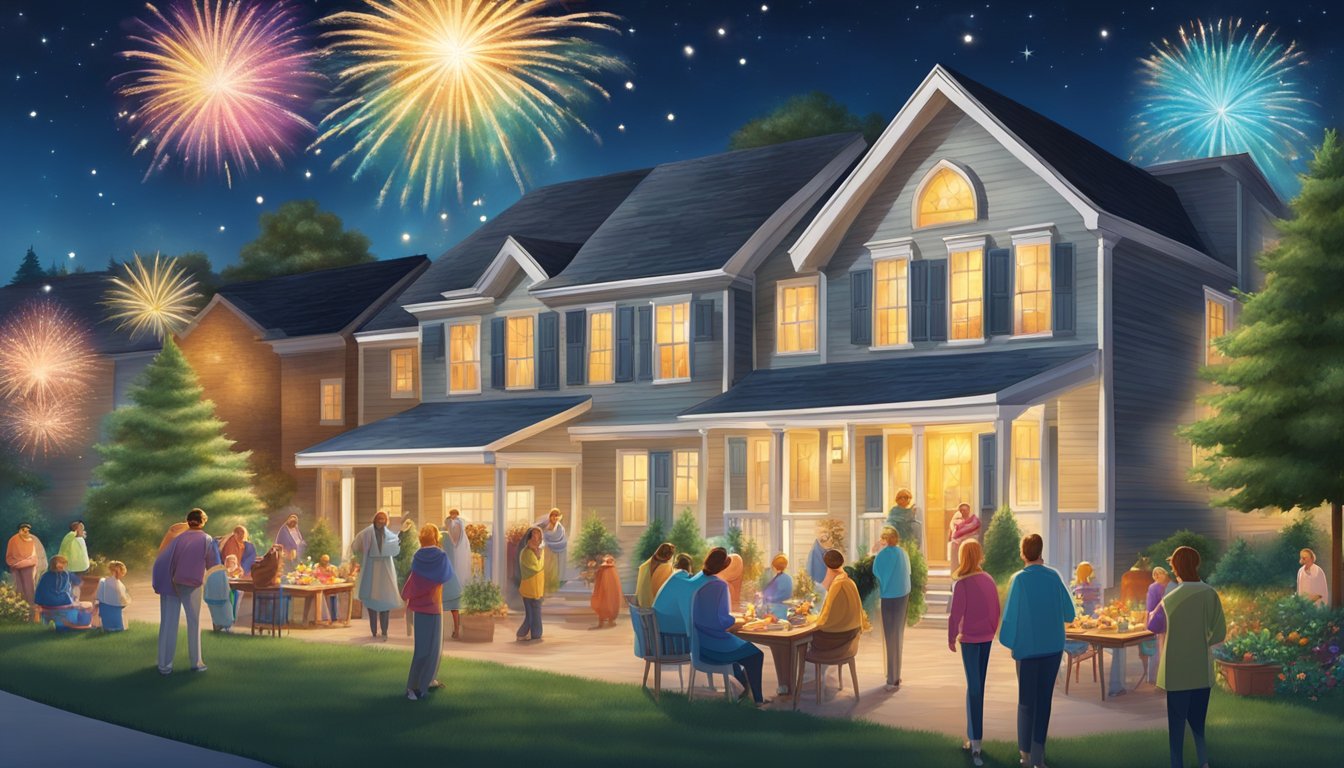
Brazilian Christmas festivities pivot around family and faith, with Christmas Eve and Day holding particular significance for social and religious activities.
Family Gatherings on December 24
Christmas Eve, or Véspera de Natal, is a time for family in Brazil.
As the sun sets on December 24, families come together to celebrate with a festive spirit.
These gatherings are sizeable and mirthful, often extending late into the night.
A common tradition sees children eagerly awaiting the arrival of Papai Noel (Santa Claus), hoping to find their shoes filled with gifts by the morning.
Christmas Day Church Services
On Christmas Day, religious devotion comes to the forefront as many families attend church services.
Churches play a crucial role in offering services to commemorate the birth of Christ.
These services are well-attended, reflecting the deep-seated religious traditions that infuse the Brazilian Christmas.
After attending the mass, families celebrate at home or with the community, often involving a leisurely day of feasting and sharing.
Festive Foods and Feasts
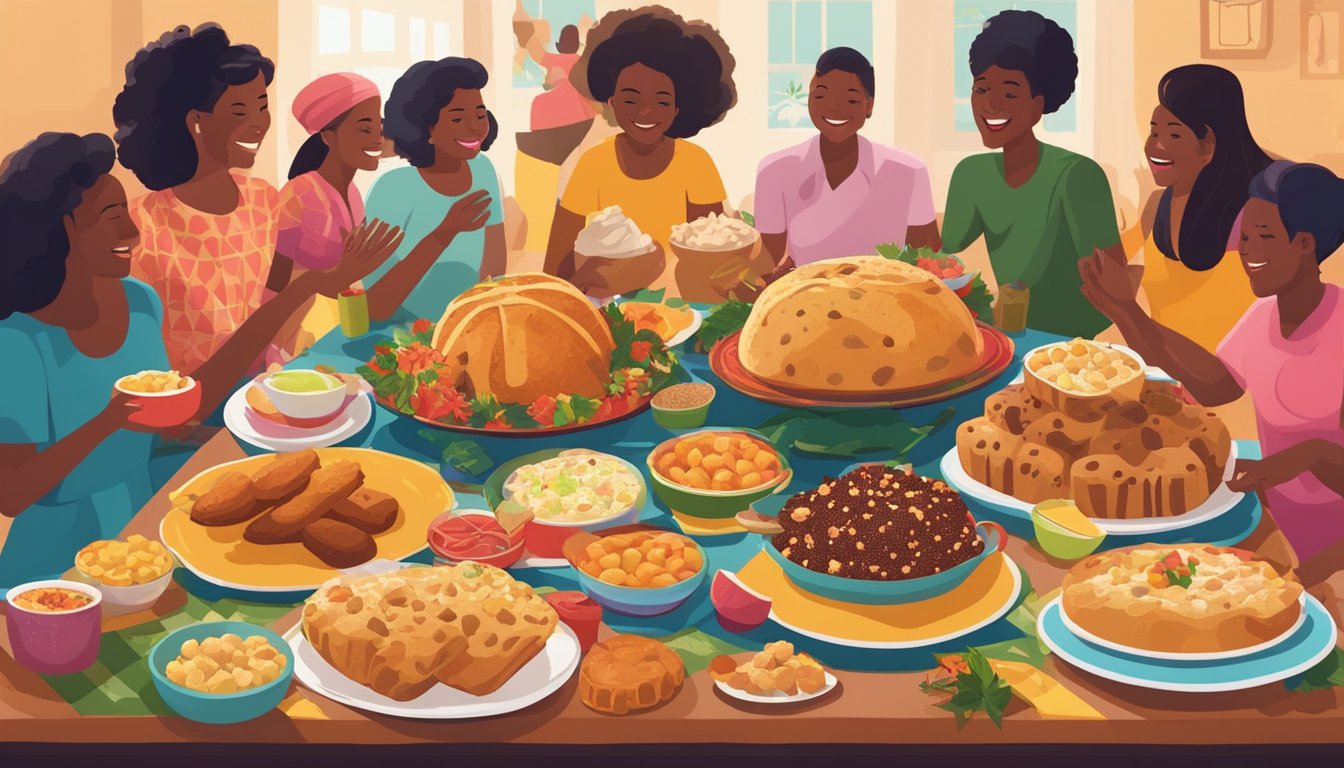
Brazilian Christmas is celebrated with various distinctive and flavorful foods central to the holiday festivities.
Main Dishes Served
The centrepiece of the Brazilian Christmas feast often includes Peru Natalino, a highly seasoned turkey that reflects the influence of American Thanksgiving.
The preparation of this turkey is meticulous, involving various spices to create a genuinely festive dish.
Pernil, another traditional mainstay, is a roast pork dish flavoured with garlic, onion, butter, rosemary, ground pepper, and lime juice.
- Turkey (Peru Natalino): Seasoned with traditional spices.
- Ham (Tender Natalino): Often glazed and served alongside the turkey.
- Cod (Bacalhau): A savoury dish that’s savoured at many Brazilian Christmas tables.
Desserts and Sweets
Brazilian Christmas would not be complete without its range of sweet treats.
The Pavê, a form of trifle that combines biscuits or cake layered with cream, condensed milk, and often brandy, is a popular dessert.
Chocolate versions are particularly beloved.
Another traditional sweet is the Rabanada, a Brazilian take on French toast, typically enjoyed for breakfast on Christmas day.
- Panettone: A sweet bread loaf with fruits and nuts, customarily of Italian origin.
- Pavê: Available in various flavours, chocolate being a favoured choice for Christmas.
Traditional Drinks
Festive drinks serve as refreshments and a toast to the season’s cheer.
While not as iconic as the food, these beverages are still essential to the celebration.
- Cachaça: A distilled spirit made from sugarcane juice, often mixed into cocktails.
- Champagne: Used to make Brazilian Christmas rice and also enjoyed as a celebratory drink.
Decorations and Symbolism
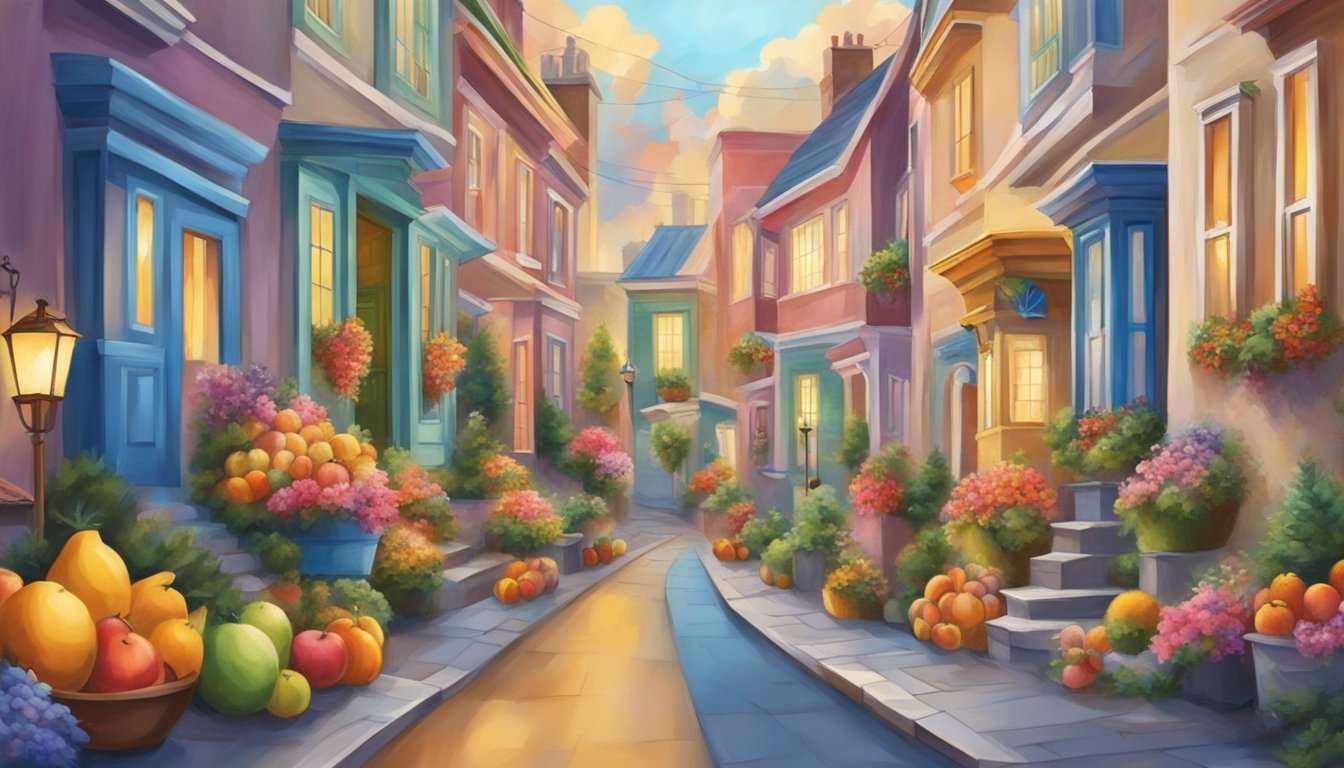
In Brazil, Christmas decorations blend traditional symbols with tropical twists to create a unique holiday aesthetic.
Shining lights and festive ornamentation transform public spaces and private homes into vibrant seasonal displays.
Christmas Trees and Ornaments
Brazilian Christmas trees are a central part of seasonal decorations, often made from plastic to adapt to the tropical climate.
They are traditionally adorned with a variety of ornaments, such as:
- Baubles: In various colours and designs to reflect light and add sparkle.
- Tinsel: Draped around the tree for a shimmering effect.
- Fairy Lights: Illuminating the tree, these lights add a magical touch to the overall display.
While the tradition of using a palm tree as a Christmas tree is mentioned, it’s more common to see the classic conifer shape, even if artificial.
The trees are embellished with familiar festive motifs, creating a sense of universality in the holiday celebration.
Light Displays and Outdoor Decor
Brazilians create elaborate light displays that illuminate neighbourhoods and landmarks, featuring:
- String Lights: They brighten up streets, buildings, and homes.
- Outdoor Decor: Ranging from inflatable Santas to elaborate nativity scenes.
These decorations convey the spirit of Christmas while embracing the warmth of the Brazilian summer season.
Public squares and streets might be draped in twinkling lights, while nativity scenes play a significant role, showcasing the holiday’s religious significance.
Christmas Music and Entertainment
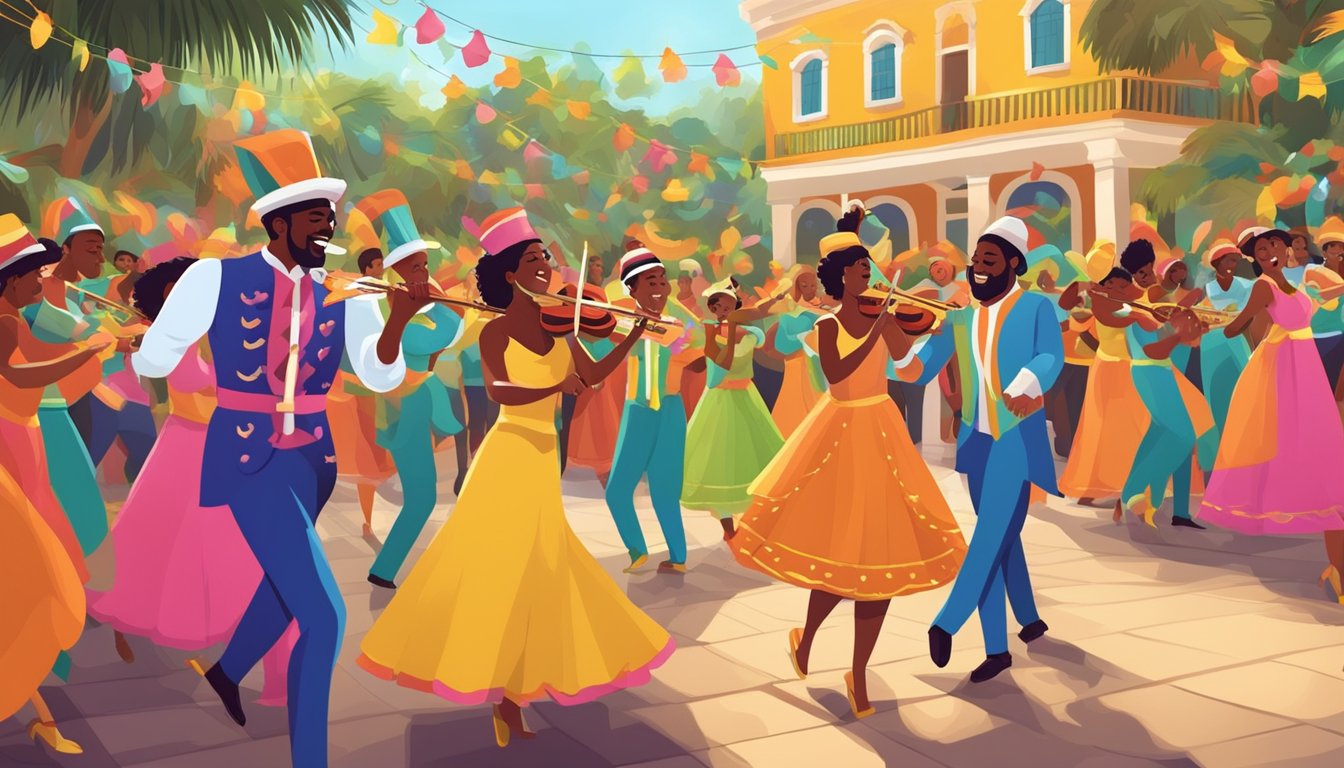
Brazilian Christmas celebrations are marked by vibrant music and various entertainment options, reflecting the country’s diverse cultural tapestry.
Regional Music Variations
Brazil’s Christmas music encapsulates the diversity of its regional cultures.
Each region adds flavour to the holiday soundtracks, informed by local musical styles and instruments.
Silent Night, known in Portuguese as Noite Feliz, is a universally popular Christmas carol in Brazil, often performed with a distinct Brazilian rhythm.
- Northeastern Brazil: Traditional forró and other folk styles infuse Christmas music with upbeat tempos and local instruments.
- Southern Brazil: Influences from European immigrants, particularly the German and Italian communities, can be heard in the Christmas music, with classic carols receiving a regional rendition.
Christmas Day Recreations
Entertainment on Christmas Day in Brazil often centres around family gatherings and communal festivities.
Music plays a crucial role in these celebrations, with religious and secular tunes contributing to the holiday atmosphere.
Live Performances: Many communities host live music events, with bands and choirs performing a mix of Christmas Songs. These include the widely cherished Noite Feliz.
Family Karaoke: It’s common for families to engage in karaoke sessions, singing various songs from the traditional Feliz Natal to more contemporary Brazilian holiday hits.
By incorporating regional music variations into Christmas and fostering an inclusive environment for entertainment on the day, Brazilians create a richly textured and memorable holiday experience.
Gift-Giving Traditions
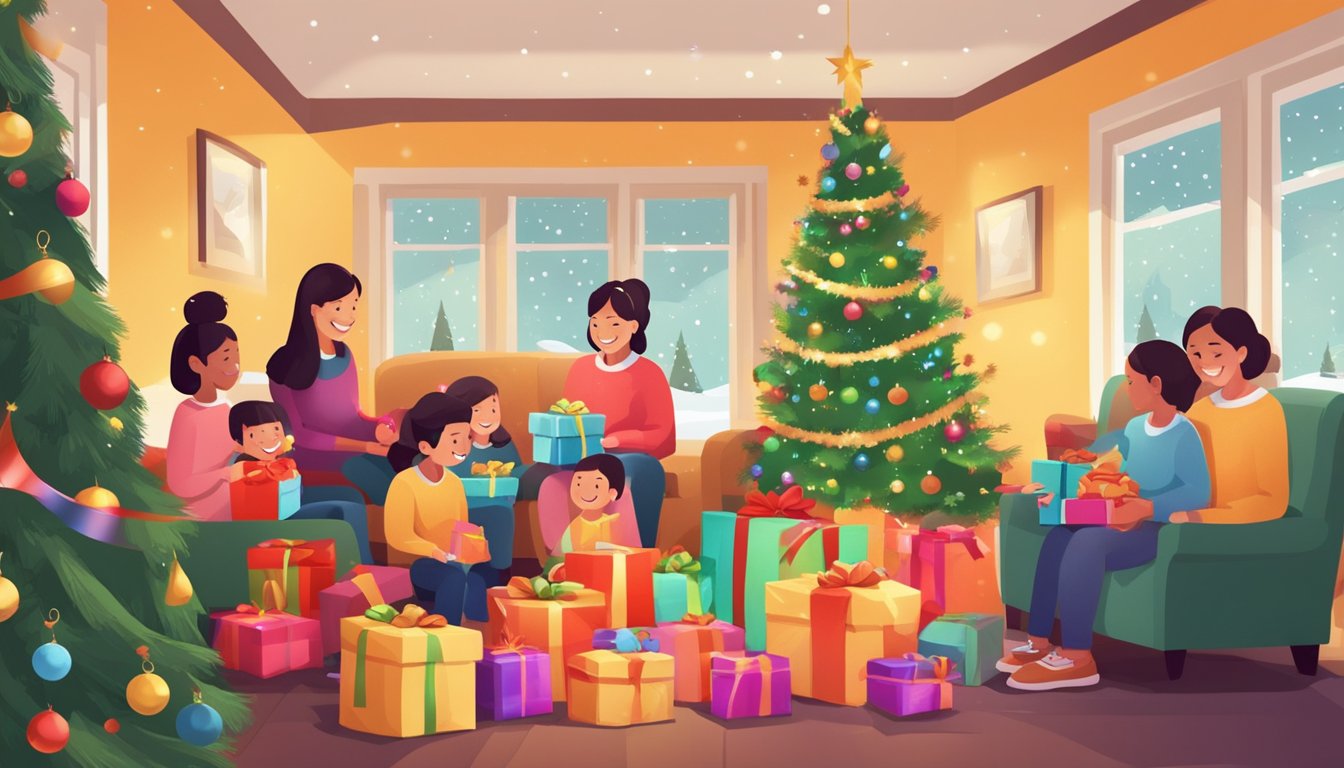
Gift-giving in Brazil is a heartwarming and essential component of holiday festivities, reflecting the nation’s generous spirit and the joyous holiday atmosphere that pervades the country during Christmas time.
Children’s Expectations for Papai Noel
Brazilian children eagerly anticipate the arrival of Papai Noel, the Brazilian equivalent of Santa Claus.
Traditionally, children leave a sock near a window on Christmas Eve, hoping Papai Noel will exchange it for presents.
In the morning, it’s a common sight to find kids gleefully surveying their gifts, which often include toys, clothes, or sweets, signalling Papai Noel’s supposed to visit during the night.
Exchange Among Adults and Friends
Among adults and friends, the tradition of Amigo Oculto, comparable to Secret Santa, is a popular means of gift exchange.
Name Drawing: Secret names are drawn well before Christmas, ensuring everyone has time to find a thoughtful gift.
Gift Presentation: Gifts are often exchanged at family gatherings or holiday parties, adding an element of surprise and enjoyment.
Symbolism: Presents serve as tokens of appreciation and affirm the bonds between friends and family members, enhancing the communal spirit of the season.
The concept of gift-giving in Brazil is deeply intertwined with celebration and community, encapsulating the joy and warmth of Brazilian Christmas traditions.
Brazil’s Christmas in Summer

In Brazil, Christmas coincides with summer, setting a unique stage for holiday festivities.
The hot climate influences how Brazilians celebrate, incorporating beach outings and seasonal activities into their traditions.
Beach Celebrations
Many Brazilians flock to the beaches during Christmas, leveraging the hot December climate for holiday relaxation and revelry.
The shoreline becomes a hub for gatherings, with family and friends convening to enjoy the sun and sea.
Beachside parties often include traditional music, dancing, and a feast of summer foods, with the following Christmas favourites:
Fresh seafood such as fish and shrimp
Tropical fruits like watermelon and mango
The beach serves as a place to unwind and a communal space for expressing joy and sharing the Christmas spirit.
Impact of Seasonal Weather on Traditions
The summer weather in December shapes Brazilian Christmas customs significantly.
Traditional holiday activities adapt to the warm temperatures, creating a vibrant contrast to the wintry Christmas scenes often depicted in other parts of the world. Here’s how the weather has an impact:
Outdoor Celebrations: Public squares and open spaces are preferred for communal gatherings, allowing people to enjoy the holiday under clear, starry skies.
Adapted Santa Claus: Brazil’s version of Santa Claus, known as ‘Papai Noel’, is often depicted wearing lighter clothing suitable for the summer heat.
The season’s warmth influences everything from holiday attire to the timing of celebrations, with many opting to hold events later in the evening when the temperatures become more pleasant.
Modern Brazilian Christmas
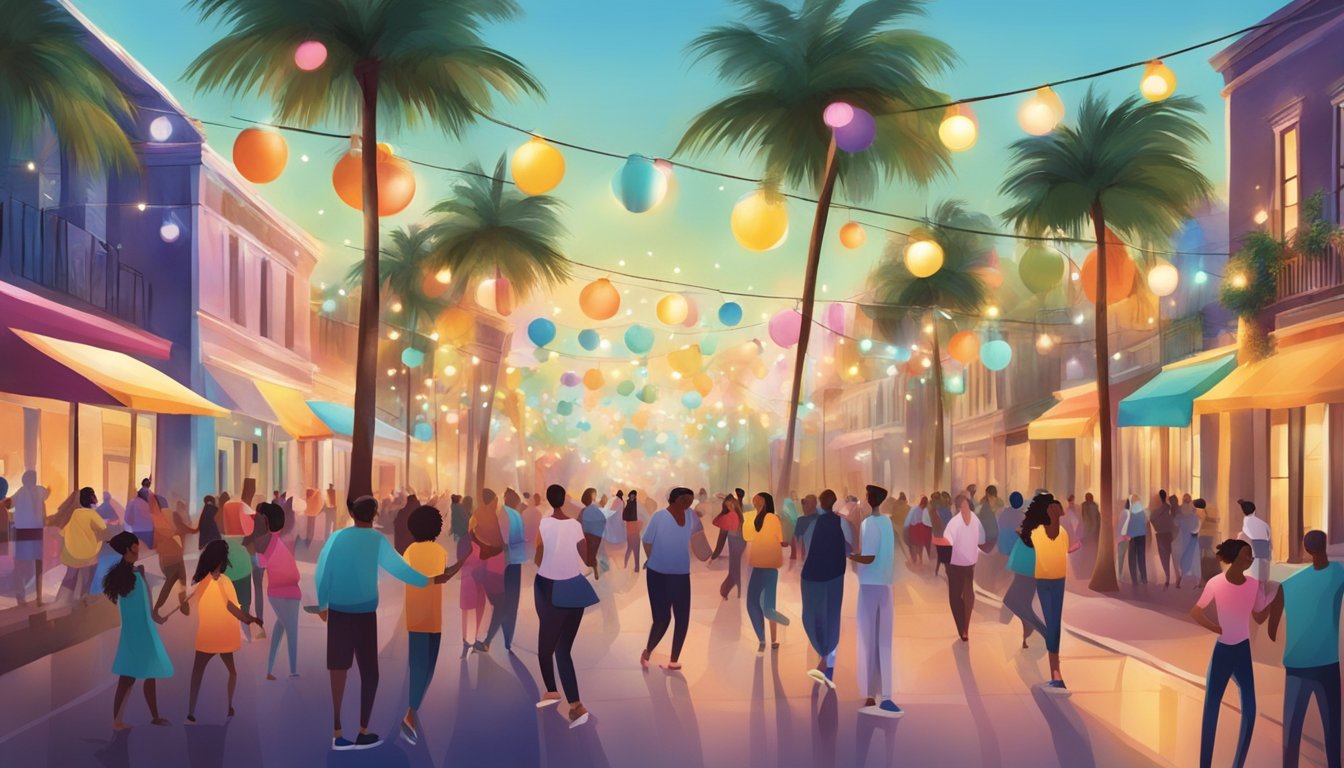
While rooted in traditional practices, the celebration of Christmas in Brazil has been reshaped by global influences and changing local customs.
This section delves into how globalization has impacted these traditions and how they continue to evolve in the modern Brazilian context.
Impact of Globalization
Globalization has introduced various aspects of Western Christmas celebrations to Brazil.
Notably, the image of Santa Claus, known in Brazil as Papai Noel, mirrors the red and white-clad figure popularized in the United States.
Despite the sweltering summer heat of December in Brazil, Papai Noel’s aesthetic remains predominantly wintry, often necessitating a lighter silk costume to adapt to the tropical climate.
Major cities like Rio de Janeiro and São Paulo cash in on the festive spirit, with businesses typically remaining open until the afternoon or early evening on December 24th, and decorations mirroring a White Christmas theme are prevalent.
Commercialization is also on full display, with advertising campaigns and store displays tailored to evoke the holiday spirit.
One of the hallmarks of the Brazilian economy during Christmas is the 13th salary payment. This year-end bonus helps fuel consumer spending and stimulates the economy during the holiday season.
Evolving Traditions and Practices
While global trends have influenced many Brazilian Christmas traditions, they continue to evolve authentically, retaining the essence of Brazilian culture.
The Ceia de Natal, the Christmas Eve dinner, is a testament to these evolving practices.
It is an eclectic feast often featuring dishes such as turkey, ham, and regional delicacies, catered to the tastes and wealth of each household.
The meal might feature chicken rather than the more costly turkey or ham in smaller households.
Family gatherings are central to Christmas celebrations, emphasizing sharing meals and exchanging gifts.
Churches across Brazil conduct midnight masses known as Missa do Galo, attended by many to renew their faith and celebrate the holiday in a traditional setting.
Moreover, the festive décor in Brazilian homes often fuses traditional elements with tropical motifs, reflecting the distinctive character of a Brazilian tropical Christmas.
Regional Variances within Brazil
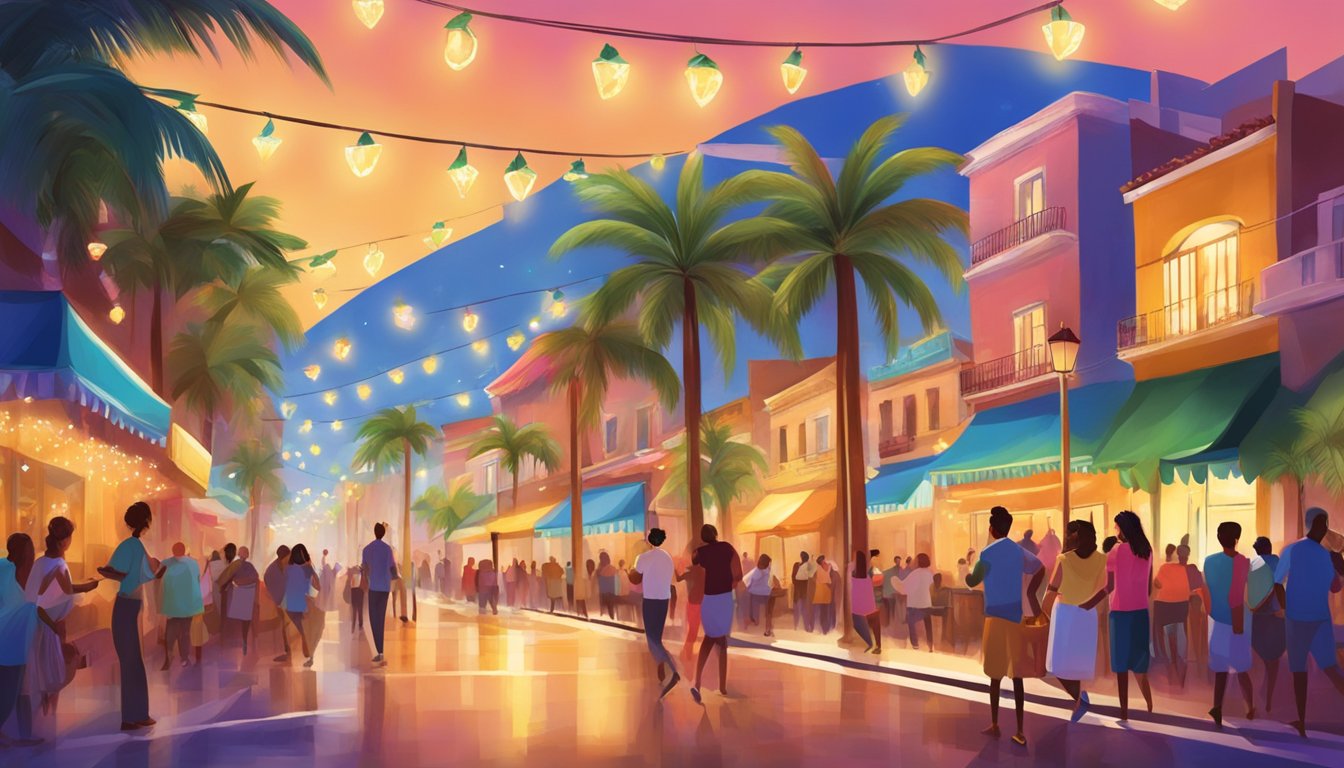
In Brazil, the way Christmas is celebrated can vary significantly from one region to another, reflecting the country’s diverse cultural landscape.
Christmas in São Paulo vs. Rio de Janeiro
São Paulo: In São Paulo, Christmas is often marked by vibrant lights and large community Christmas trees. The city has a tradition of hosting “Natal Iluminado,” where streets and buildings are adorned with spectacular light displays.
Paulistanos, the residents of São Paulo, may also attend special church services, such as the “Missa do Galo” or Midnight Mass.
Rio de Janeiro: Rio de Janeiro celebrates with its unique coastal charm. The iconic Copacabana Beach becomes a festive hub, including extravagant firework displays.
“Papai Noel” arrives in style, sometimes seen trading his traditional sleigh for a surfboard.
Rio’s Christmas is also known for its live music concerts, often held outdoors to take advantage of the warm summer nights.
Local Traditions across different States
Bahia: In the northeastern state of Bahia, one can experience the “Noite da Paz” (Night of Peace), where local churches carry out masses with African-Brazilian music. The fusion of cultural elements is on full display, including the influence of Candomble, an Afro-Brazilian religious tradition.
Minas Gerais: The state of Minas Gerais is famous for its “Presépio”tradition and elaborate nativity scenes depicting the birth of Jesus. Artisans craft intricate figures and settings proudly displayed throughout homes and public spaces.
Pernambuco: Pernambuco offers a distinct experience with “Ciclo Natalino,” which features “Pastoril,” a traditional folk play that includes organized dance and singing performances that revolve around the nativity story.
Religious Reflection and Practices
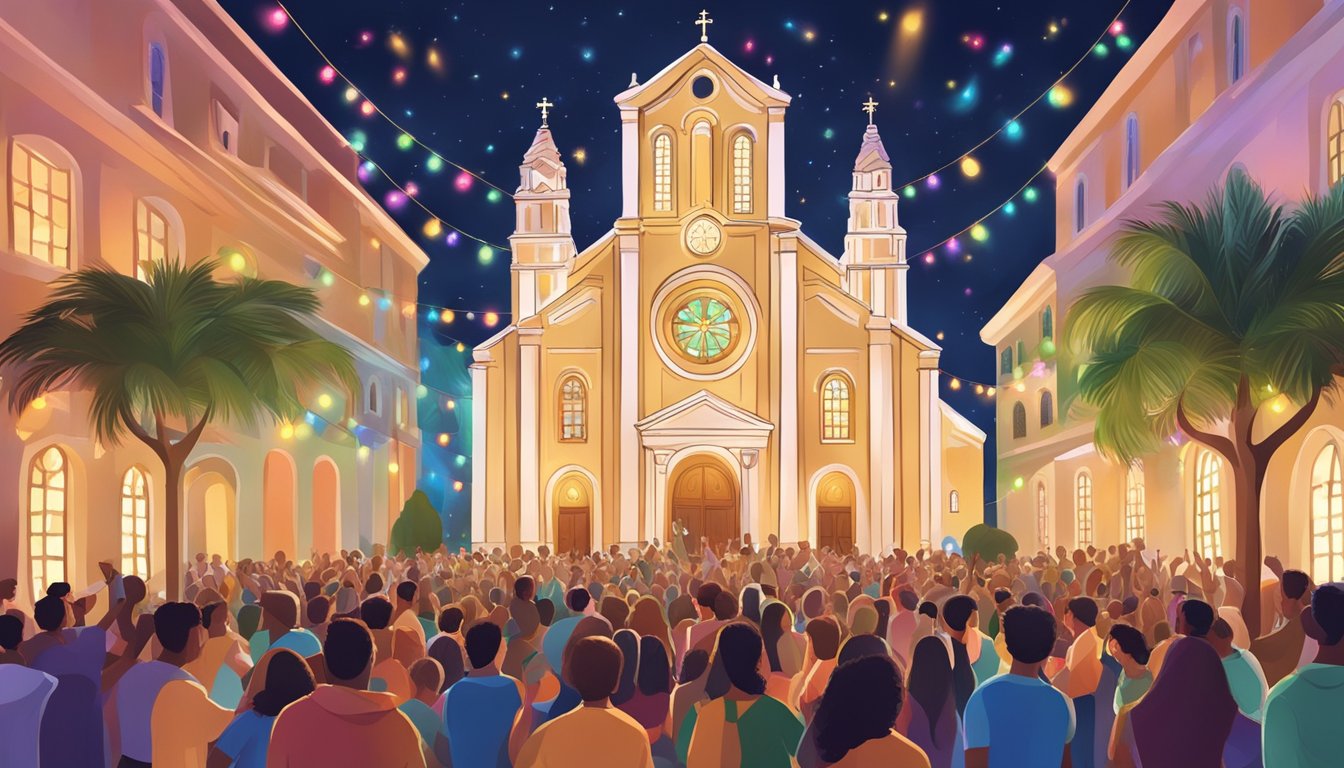
Christmas in Brazil is deeply rooted in religious traditions, with the Catholic Church playing a central role in the season’s reflections and observances.
Nowhere is this more evident than in the activities that unfold within churches and during specific holidays like Three Kings Day.
Role of Churches during Christmas
Churches are the epicentre of spiritual reflection during the Christmas season.
The “Missa do Galo”, or Mass of the Rooster, is a pivotal service held on Christmas Eve, where congregations gather at midnight in anticipation of Christ’s birth.
This mass is named for the notion that the only time a rooster crowed at midnight was when Jesus was born.
As most Brazilians are Catholic, these services are heavily attended, with families coming together to reaffirm their faith.
Three Kings Day Celebrations
Following Christmas, Three Kings Day, or Dia dos Reis, is celebrated on January 6th, commemorating the Epiphany.
This day marks the Biblical arrival of the three wise men to visit the infant Jesus.
Churches often hold special masses and community events.
It is typical for religious processions and reenactments of the wise men’s journey to be part of the observance.
This celebration officially closes the Christmas festivities in Brazil, with many seeing it as a time of reflection upon the revelation of God incarnate as Jesus Christ.
Frequently Asked Questions
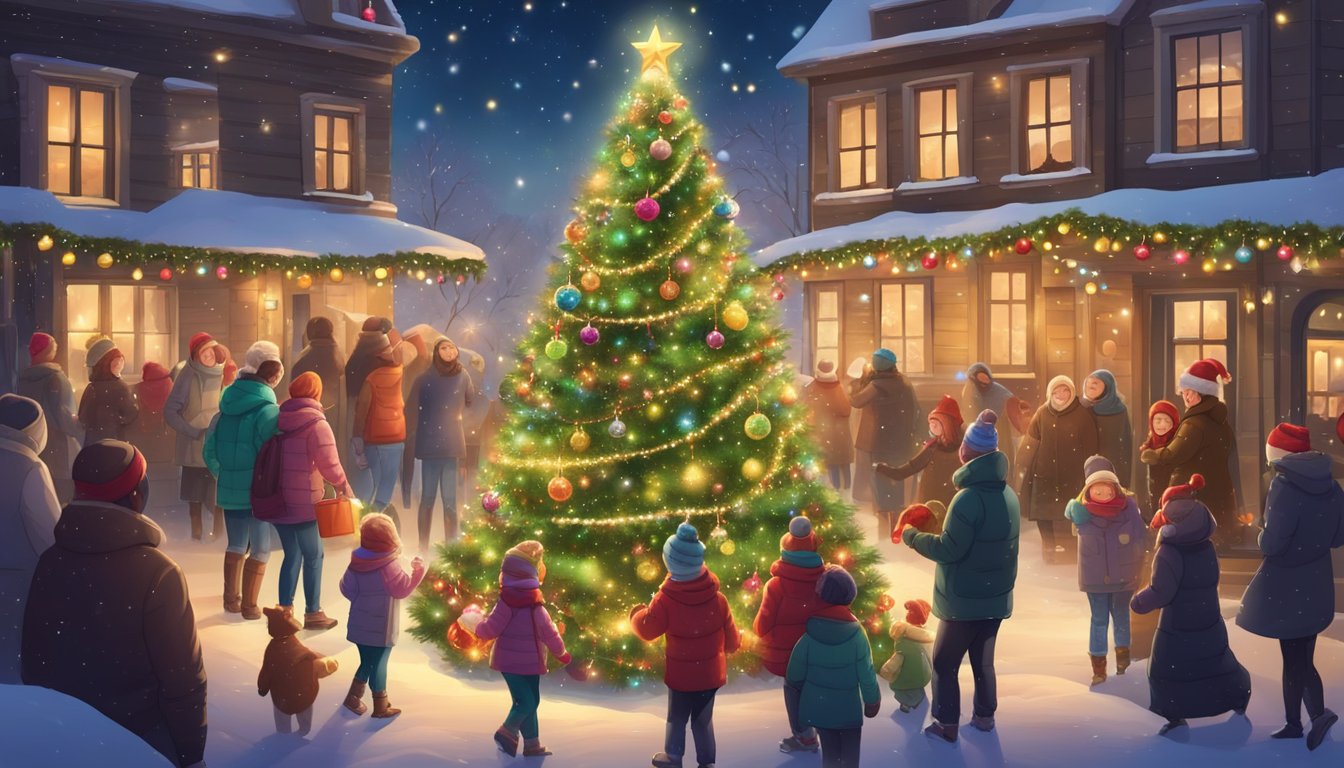
What are common Christmas traditions in Brazil?
Brazilian Christmas customs are a blend of local and imported traditions.
For instance, they uniquely celebrate ‘Amigo Secreto’, a version of Secret Santa, which involves drawing names and purchasing a present for the selected individual.
Which foods are traditionally eaten during Christmas in Brazil?
Christmas foods such as turkey, coloured rice, and various fruits are central to Brazil’s Christmas cuisine. ‘Rabanada’, a type of bread similar to French toast, is also a festive favourite.
How is Christmas celebrated in different regions of Brazil?
Christmas celebrations can vary widely from region to region in Brazil.
While some areas may have elaborate fireworks, others might showcase nativity plays or ‘Folia de Reis’, a traditional folk play.
What are some unique decorations used for Christmas in Brazil?
Brazilians commonly use fresh flowers and nativity scenes to decorate their homes.
In addition, due to the summer season, decorations may also include tropical elements.
Who is the Brazilian equivalent of Santa Claus, and how is he depicted?
The Brazilian equivalent of Santa Claus is known as ‘Papai Noel’. He is depicted similarly to the Santa Claus known in the United States, albeit often clad in lighter clothing due to the warmer climate.
Are there specific gifts that are commonly exchanged in Brazil during Christmas?
While gift-giving practices are diverse in Brazil, popular gifts often include clothing, toys for children, and handmade or locally sourced items that reflect Brazilian culture and craftsmanship.


